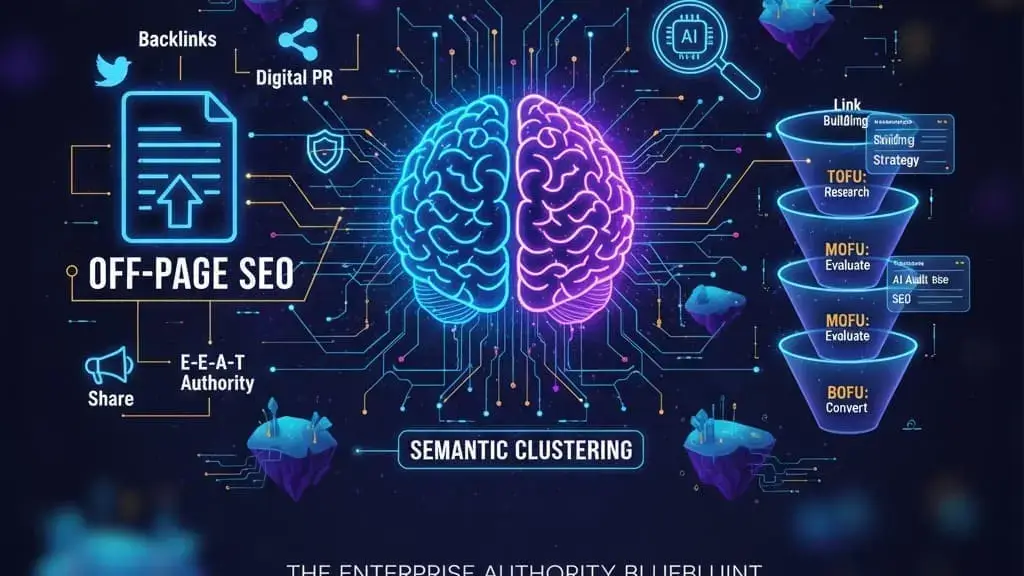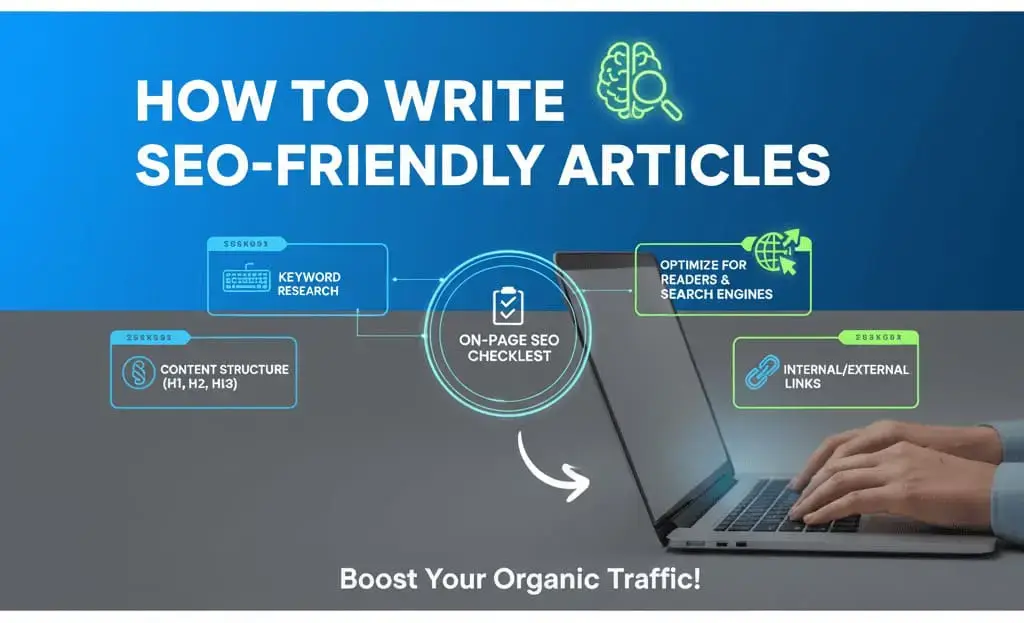Discover how semantic Off-Page SEO transforms your enterprise into an AI-ready authority. In this blueprint, we decode Microsoft-aligned strategies to build trust, accelerate link acquisition, and dominate modern search rankings.
I. Strategic Imperatives: Off-Page SEO, Enterprise Authority & the AI Era
1.1 Why Semantic Off-Page SEO Is the Foundation of Enterprise Authority
Off-Page SEO embodies external validation—it’s how your domain builds trust, signals authority, and acquires measurable ranking strength beyond internal content optimization. While On-Page SEO optimizes internal structure, content, UX, and keyword usage, Off-Page SEO is about what others say about you: backlinks, brand mentions, social references, influencer signals, and third-party endorsements.
-
Backlinks remain one of Google’s strongest ranking signals. Neglecting link acquisition makes it nearly impossible to compete for high-difficulty keywords in competitive industries.
-
While On-Page SEO can yield early improvements within weeks, meaningful impact from Off-Page SEO generally takes 2 to 6+ months of consistent execution.
-
In the era of E-E-A-T (Experience, Expertise, Authoritativeness, Trustworthiness), Off-Page SEO is the external “proof” mechanism. High-quality backlinks, authoritative citations, and brand mentions substantiate your domain’s E-E-A-T posture.
- If you’re looking to build enterprise-level authority through a structured Off-Page SEO strategy, our Off-Page SEO Services help your brand earn authoritative links and citations that drive long-term rankings.
Because search engines increasingly treat E-E-A-T as a signal for quality, your strategy must evolve beyond keyword optimization. Your content must be capable of attracting external validation — expert author bios, original data, and compelling case studies lend credibility and linkability.
1.2 Aligning with Microsoft’s AI Structured Data & Trust Signals
When building enterprise-scale SEO, alignment with AI-first search paradigms is essential. Microsoft’s recent advice underscores this:
-
Structure content carefully (clear headings, self-contained passages) so AI systems can “lift” meaningful answers. Use schema markup, FAQ blocks, and conversational formatting to help AI systems parse and understand your content.
-
In a controlled test, only the page with robust schema implementation appeared in an AI Overview and achieved top ranking.
Thus, to perform in both classic search and in AI-powered answer engines, your content must be deeply structured, semantically coherent, and trust-anchored. A semantic clustering approach (versus isolated keyword targeting) enables better alignment with LLM-driven systems that prize context and entity relationships.
Further, thought leadership and Digital PR are not optional — they serve as the bridge between content and external authority, making your high-risk, competitive keywords tractable.
II. Foundational Methodology: Intent Mapping, Semantic Clusters & Priority Scoring
2.1 Mapping Search Intent: The “Why” Behind Each Keyword
Keyword research should start with intent — what is the user trying to accomplish? Semantic clustering groups keywords by shared meaning and intent, not merely lexical similarity. ClickRank+1
Intent is classically divided into three core types (which align with the funnel):
| Intent | Searcher Goal | Funnel Phase | Content Type | Off-Page Focus |
|---|---|---|---|---|
| Informational | Learn or define a concept (e.g. “what is off-page SEO”) | TOFU | Guides, checklists, content hubs | Earn brand mentions, social shares |
| Commercial Investigation | Explore methods, tools, and comparisons | MOFU | Deep case studies, workflows, comparative guides | Secure expert citations, niche backlinks |
| Transactional | Ready to act — services, tools, procurement | BOFU | Service pages, ROI calculators, testimonials | Acquire high-authority links to conversion pages |
This alignment ensures your content both serves the user and is optimized for external authority-building. Want to ensure your On-Page SEO aligns perfectly with user intent and AI search systems? Explore our On-Page SEO Optimization Service to build semantic depth and an AI-ready content structure.
2.2 Strategic Metrics: Volume, Difficulty & Prioritization
To structure content investments, you’ll track:
-
Search Volume (SV) — potential traffic opportunity
-
Keyword Difficulty (KD) — estimated ranking competitiveness
-
Strategic Priority Score — a custom score (1–5) combining intent, difficulty, and revenue alignment
Example benchmark ranges (for enterprise-level sites):
-
KD 0–29: Low competition — suitable for quick wins
-
KD 30–49: Mid competition — requires additional off-page support
-
KD 50–69: Hard — needs strong domain authority & link strategy
-
KD >70: Highly competitive — reserved for established domains
Keywords with commercial or transactional intent often get a higher priority score even if difficulty is high, as their revenue potential justifies investment.
2.3 Semantic Clustering + Intent Mapping Framework
Clusters group keywords by topical intent rather than mere lexical match. Each cluster addresses a cohesive subtopic of your core theme, with attention to the funnel stage and off-page needs.
| Intent Type | Primary Goal | Funnel Stage | Format | Off-Page Focus |
|---|---|---|---|---|
| Informational | Understand the core concept | TOFU | Ultimate guides, checklists | Shareability, mentions |
| Commercial Investigation | Learn methods & workflows | MOFU | Detailed case studies, tool comparisons | Expert mentions niche backlinks |
| Transactional | Acquire service/tool | BOFU | Service pages, ROI tools | High-authority links to money pages |
This framework ensures every piece of content maintains a clear role and link-building objective.
III. Keyword Strategy: Data-Driven Clusters & Content Themes
Below is a refined cluster model you can adapt (with keyword research tools for your niche):
3.1 Cluster 1 — Off-Page Fundamentals & Awareness (TOFU / early MOFU)
Keywords: off-page SEO checklist, what is off-page SEO, how off-page SEO helps ranking
Intent: Informational → early awareness
KD target: 20–35
Goal: Rapid domain topical coverage and traffic acquisition
3.2 Cluster 2 — Tactical Link Acquisition Methods (MOFU)
Keywords: broken link building 2025, turn unlinked mentions into links, competitor backlink gap strategy
Intent: Commercial investigation
KD target: 30–45
Goal: Attract mid-funnel readers and nurture them into deeper assets
Need hands-on help with white-hat link acquisition or guest posting outreach? Our Guest Posting Services connect your brand with top-tier publishers and niche-relevant platforms to accelerate your Off-Page SEO growth.
3.3 Cluster 3 — Digital PR, E-E-A-T & Brand Authority (High-Value MOFU)
Keywords: enterprise digital PR strategies, applying E-E-A-T to off-page SEO, brand mention link building
Intent: Thought leadership / credibility-building
KD target: 45–55
Goal: Earn high-value citations and establish authority
3.4 Cluster 4 — Backlink Audits & Outsourcing (BOFU)
Keywords: best B2B backlink audit tools, outsource link building services, backlink ROI calculator
Intent: Transactional
KD target: 50–65
Goal: Convert qualified leads with service pages & conversion signals
3.5 Cluster 5 — Hyper-Specific & Long-Tail (TOFU / MOFU)
Keywords: AI tools for link-building outreach, best backlink checker 2025, off-page SEO audit checklist PDF
Intent: Niche exploration/tool discovery
KD target: 15–29
Goal: Capture micro-niches and low competition queries
You can assemble a Priority Matrix mapping cluster to the strategic score and funnel stage, as you originally outlined.
IV. Tactical Content Plan & Funnel Mapping
4.1 Journey Mapping: TOFU → MOFU → BOFU
-
TOFU: Clusters 1 + 5. Content must be accessible, shareable, and structured for snippet potential.
-
MOFU: Clusters 2 + 3. Use rigorous case studies, workflows, original data, and schema to earn expert links.
-
BOFU: Cluster 4. Focus on conversion — service pages, ROI tools, testimonials, transparent results.
4.2 Content Blueprint & Title Suggestions
| Funnel | Cluster | Sample Title | Purpose & E-E-A-T Features |
|---|---|---|---|
| TOFU | C1 | The Ultimate Off-Page SEO Checklist (2025 Edition) | Comprehensive guide + checklist; author bio + data |
| MOFU | C2 | Backlink Gap Analysis: 6-Step Workflow for Competitor Audits | Tactical playbook, example data, stepwise approach |
| MOFU | C3 | Moving Beyond Links: How Digital PR Anchors Enterprise E-E-A-T | High-level strategic narrative with case references |
| MOFU | C5 | Top AI Outreach Tools for Scalable Link Building | Tool comparison + pros/cons, use cases |
| BOFU | C4 | Outsourcing Link Building: ROI, Risks & Partner Selection | Clear call-to-action, testimonial, audit metrics |
Each content piece should include schema (FAQ, HowTo, Article), internal linking, and modular writing with clear subheadings. Our Content SEO and Optimization Services can help you implement schema, internal link silos, and structured writing frameworks — ensuring your content ranks and converts.
V. Execution & Link Acquisition Strategy
5.1 KD-Driven Investment
Your link-building investment should scale with KD:
-
For KD 0–29: focus on optimizing internal linking, reclaiming unlinked mentions, and low-hanging directories
-
For KD 30–49: deploy guest posting, broken link outreach, link gap campaigns
-
For KD 50+: leverage proactive Digital PR, expert outreach, and data-driven assets
-
For KD >70: sustained brand campaigns, creative partnerships, and long-term authority plays
5.2 AI Integration & Outreach Efficiency
Modern enterprise link operations must integrate AI to maintain scale and relevance. Use AI for:
-
Backlink profile analysis, toxicity filtering, link gap detection
-
Personalized outreach email generation and sequencing
-
Predicting domain authority potential for outreach prioritization
-
Automating follow-up patterns (while retaining manual oversight)
5.3 Digital PR + Monitoring & Link Hygiene
-
Repurpose high-value content via press distribution, guest syndication, and newsletters
-
Engage in thought leadership on podcasts, panels, and industry sites
-
Maintain regular backlink audits: monitor anchor-text ratios (e.g. branded vs partial-match vs exact), remove toxic links, implement 301s for broken links
-
Adapt internal linking as new link acquisitions shift authority flows
VI. Conclusion & Next Steps
The modern enterprise SEO paradigm demands more than on-page polish — it requires a systematic Off-Page authority engine. That engine is powered by semantic clusters, AI-friendly content structure, and disciplined link acquisition.
Key takeaways:
-
Semantic clustering over keyword chasing ensures content is contextual and AI-compatible.
-
Align content with funnel + intent to maximize relevance and conversion.
-
KD should dictate resource allocation — low-difficulty content can be internally-led; high-difficulty content needs PR and high-authority support.
-
AI and schema are now essential, not optional — content must be parsed, trusted, and lifted by machine systems.
-
Continuous link hygiene and monitoring sustain authority over time.
Next steps:
-
Use keyword tools to validate and expand clusters in your niche
-
Build your first 3–5 content pieces (TOFU → MOFU) with schema and modular structure
-
Launch a Digital PR outreach plan aligned with your flagship content
-
Audit your existing backlink portfolio and reclaim unlinked mentions
-
Monitor results, rankings, and link acquisition monthly — iterate based on feedback




Pingback: 10 Types of Content Writing for a Successful Business - Marketing Scrappers
Pingback: Semantic Off-Page SEO Examples for Small Websites: Practical, Actionable Guide